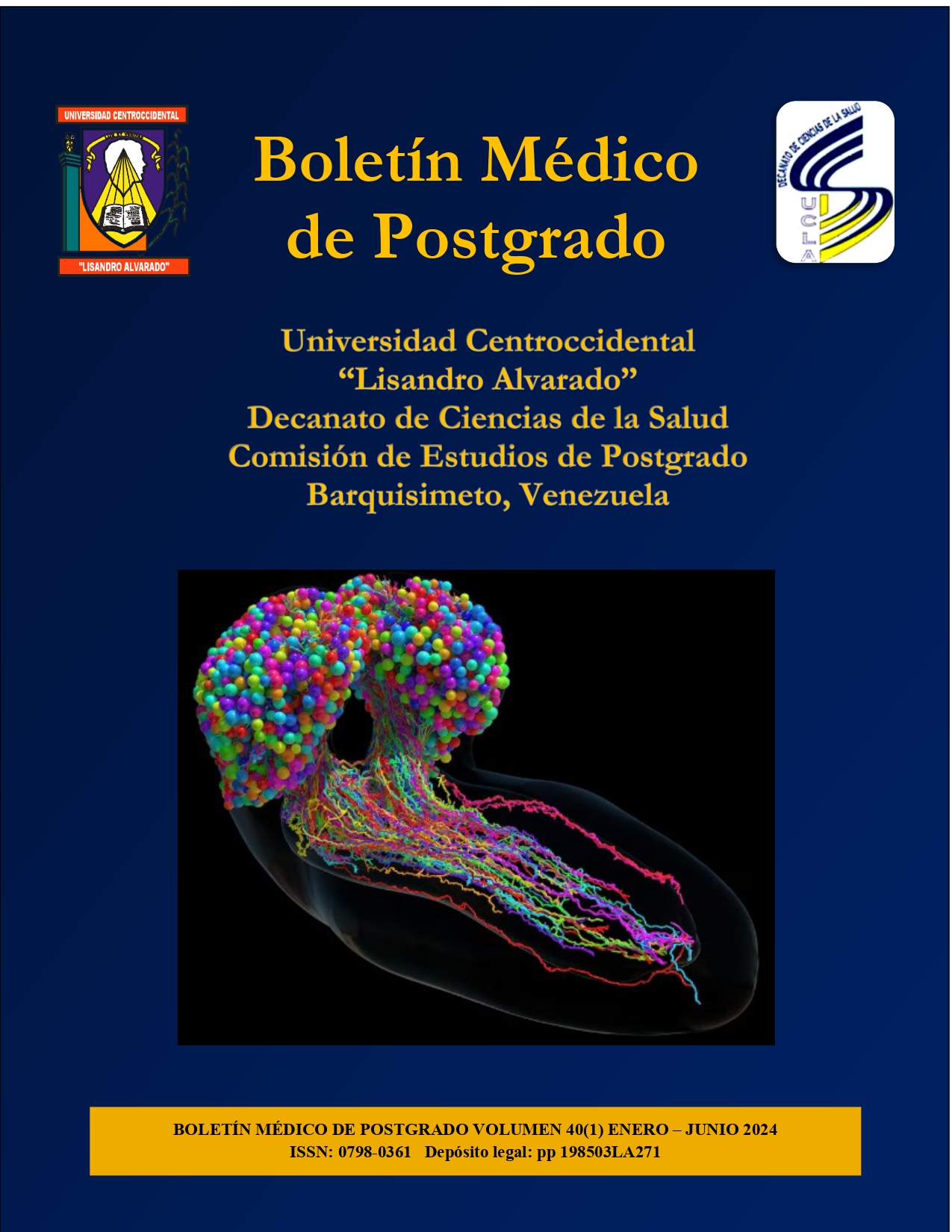Cardiovascular risk in patients with non-alcoholic fatty liver disease
Keywords:
non-alcoholic fatty liver disease, cardiovascular risk, ultrasound, abdomen, body mass indexAbstract
In order to analyze the cardiovascular risk factors in patients with non-alcoholic fatty liver disease (NAFLD) who attended the Genus health center during the period April-October 2022, a descriptive cross-sectional study was carried out selecting 30 patients who were characterized by an average age of 47.1 ± 13.6 years, where the most affected group was 51-60 years (26.6%) with a predominance of female sex (53.3%). Patients with NASH were classified by abdominal ultrasound, reporting 66.6% grade I steatosis, 30% grade II and 3.3% grade III. Nutritional status by body mass index was overweight (46.6%), obesity I (30%) and normal weight (16.6%). Glutamic oxaloacetic and pyruvic transaminases were reported as normal in 83.3% of the cases. Low, 33.3% moderate and 10% high cardiovascular risk were reported in 56.6% of the cases. When the severity of NAFLD and cardiovascular risk were related, 55% of the patients with steatosis I had low, 30% moderate and 15% high risk. However, 66.6% of patients with steatosis II showed low risk and 33.3% moderate risk. All cases with steatosis III showed moderate risk. In conclusion, the detection of NASH on conventional ultrasound examination should alert clinicians to the likely coexistence of multiple underlying cardiovascular risk factors that should be investigated and treated.
Downloads
References
Aguilera A. Esteatosis hepática no alcohólica: una enfermedad silente. Rev Med Inst Mex Seguro Soc 2018; 56(6): 544.
Younossi Z, Anstee Q, Marietti M, Hardy T, Henry L, Eslam M. Global burden of NAFLD and NASH: trends, predictions, risk factors and prevention. Nat Rev Gastroenterol Hepatol 2018; 15: 11-20.
Anstee Q, Mantovani A, Tilg H, Targher G. Risk of cardiomyopathy and cardiac arrhythmias in patients with nonalcoholic fatty liver disease. Nature Rev Gastroenterol & Hepatol 2018; 15: 425-439.
Sahuquillo A, Solera J, Rodríguez J, Celada A, Tarraga M, Tárraga P. Esteatosis hepática no alcohólica y factores de riesgo cardiovascular en atención primaria. Rev Colomb Gastroenterol 2016; 31(4): 368-375.
Cuenza L, Razon T, Dayrit J. Correlation between severity of ultrasonographic nonalcoholic fatty liver disease and cardiometabolic risk among Filipino wellness patients. J Cardiovasc Thorac Res 2017; 9(2): 85-89.
Ichikawa K, Miyoshi T, Osawa K, Miki T, Toda H, Ejiri K, et al. Prognostic value of nonalcoholic fatty liver disease in predicting cardiovascular events in patients with diabetes mellitus with suspected coronary artery disease: a prospective cohort study. Cardiovasc Diabetol 2021; 20(8).
De Armas Y. (2015). Riesgo cardiovascular y alteraciones de intima/media de las arterias carótidas en pacientes con esteatosis hepática no alcohólica. Trabajo de Grado presentado como requisito para optar al grado de Especialista en Medicina Interna. Universidad de Carabobo, Venezuela.
Sahuquillo A, Ramírez J, Torres M, Solera J, Tárraga P. La ecografía, técnica diagnóstica en esteatosis hepática no alcohólica. Journal of Negative and No Positive Results 2020; 5(4): 392-427.
Pando R. (2020). Riesgo cardiovascular con esteatosis hepática no alcohólica en diabéticos tipo 2 y en no diabéticos. Hospital Nacional Dos de Mayo. Lima 2017. Tesis para optar el Grado Académico de Doctor en Medicina. Universidad Nacional Mayor de San Marcos, Lima, Perú.
Monteros P, Sornoza H. Esteatosis hepática no alcohólica y la cuantificación de las enzimas hepáticas: ¿Cuánto aportan al diagnóstico? Dom Cien 2021; 7(2): 168-184.
Arnett D, Blumenthal R, Albert M, Buroker A, Goldberger Z, Hahn E, et al. 2019 ACC / AHA Guideline on the Primary Prevention of Cardiovascular Disease: A Report of the American College of Cardiology/American Heart Association Task Force on Clinical Practice Guidelines. Circulación 2019; 140(11): e596-e646.
Lonardo A, Ballestri S, Guaraldi G, Nascimbeni F, Romagnoli D, Zona S, et al. El hígado graso se asocia con un mayor riesgo de diabetes y enfermedad cardiovascular, evidencia de tres modelos de enfermedad diferentes: NAFLD, VHC y VIH. Mundo J Gastroenterol 2016; 22(44): 9674-93.
Published
How to Cite
Issue
Section

This work is licensed under a Creative Commons Attribution-NonCommercial-ShareAlike 4.0 International License.
Las opiniones expresadas por los autores no necesariamente reflejan la postura del editor de la publicación ni de la UCLA. Se autoriza la reproducción total o parcial de los textos aquí publicados, siempre y cuando se cite la fuente completa y la dirección electrónica de esta revista. Los autores(as) tienen el derecho de utilizar sus artículos para cualquier propósito siempre y cuando se realice sin fines de lucro. Los autores(as) pueden publicar en internet o cualquier otro medio la versión final aprobada de su trabajo, luego que esta ha sido publicada en esta revista.



